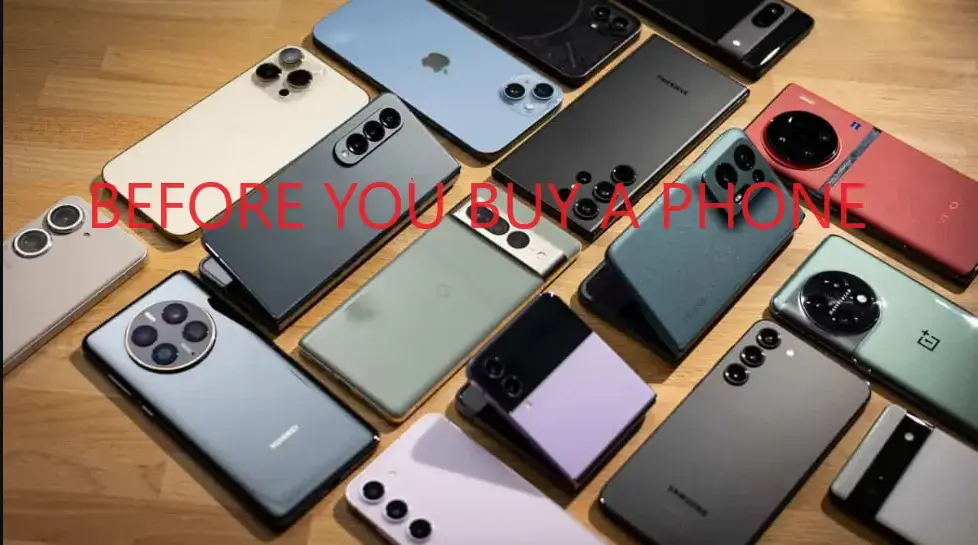Before You Buy a phone : in today’s digital age, smartphones have become an essential part of our lives. They serve as our communication tools, personal assistants, entertainment centers, and much more. With the plethora of options available in the market, choosing the right smartphone can be overwhelming. This guide will help you understand the key factors to consider before making your purchase.

What I need to know before I buy a smartphone!
1. Operating System (OS)
Before You Buy a phone : Android vs. iOS
The two main operating systems for smartphones are Android and iOS. Each has its own set of advantages and disadvantages:
- Android: Offers a wide variety of devices from different manufacturers, customizable user experience, and a broad selection of apps.
- iOS: Exclusive to Apple‘s iPhones, known for its smooth performance, consistent updates, and strong security.
Other Operating Systems
While Android and iOS dominate the market, other operating systems like HarmonyOS (by Huawei) also exist, but they are less common and have fewer apps and support.
2. Build Quality smartphones
Material
Smartphones come in various materials, including plastic, metal, and glass. Glass builds often look more premium and feel more solid, but they can be more fragile compared to plastic or metal.
Durability of smartphones
Look for features like Gorilla Glass protection, water and dust resistance (IP ratings), and drop test certifications if you need a durable phone.
3. Display
Size
Screen size is a personal preference, typically ranging from 5 inches to 7 inches. Consider how you plan to use your phone; larger screens are great for media consumption, while smaller screens are more portable.
Resolution
Higher resolution screens (Full HD, QHD, 4K) offer better clarity and detail. For most users, a Full HD (1080p) screen is sufficient.
Technology
AMOLED and OLED displays offer better color reproduction and deeper blacks compared to LCD screens. However, they can be more expensive.
4. Performance
Processor
The processor (CPU) determines the phone’s performance. High-end processors (like Snapdragon 8-series, Apple A-series) offer better performance and future-proofing.
RAM
More RAM allows for better multitasking and smoother performance. For most users, 4GB to 8GB of RAM is adequate, while power users might prefer 12GB or more.
5. Camera Quality
Megapixels
While higher megapixels can mean better photo quality, they are not the only factor. Sensor size, aperture, and software optimization play crucial roles.
Features
Look for additional camera features like optical image stabilization (OIS), night mode, portrait mode, and the number of cameras (wide, ultra-wide, telephoto).
6. Battery Life
Capacity
Battery capacity is measured in milliampere-hours (mAh). Higher mAh typically means longer battery life, but it also depends on the phone’s efficiency and screen size.
Charging
Consider phones with fast charging capabilities, wireless charging, and USB-C ports for future-proofing.
7. Storage
Internal Storage
Most modern smartphones come with 64GB to 512GB of internal storage. If you store a lot of media files or use many apps, opt for higher storage options.
Expandable Storage
Some Android phones offer microSD card slots for expandable storage, which can be a cost-effective way to increase storage capacity.
8. Software and Updates
OS Updates
Ensure the phone you choose receives regular software updates, which are crucial for security and new features. iPhones generally receive updates for longer periods compared to most Android phones.
User Interface
Different manufacturers offer different user interfaces (UI) on top of Android (e.g., Samsung’s One UI, Xiaomi’s MIUI). Try them out to see which one you prefer.
9. Network and Connectivity
5G
5G is the latest in mobile connectivity, offering faster internet speeds. If future-proofing is important to you, consider a 5G-capable phone.
Dual SIM
If you need to manage two phone numbers, look for a phone with dual SIM capability.
10. Price
Budget
Smartphones are available in various price ranges: budget (under $300), mid-range ($300-$600), and flagship (over $600). Determine your budget and prioritize the features most important to you.
Value for Money
Mid-range phones often offer the best balance of performance, features, and price. Flagship phones come with the latest technology but at a premium.
11. Brand and After-Sales Support
Reputation
Research the brand’s reputation for build quality, customer service, and software updates.
Warranty and Support
Consider the warranty period and availability of customer service centers in your region.
12. Additional Features
Biometrics
Fingerprint sensors, facial recognition, and iris scanners offer convenient and secure ways to unlock your phone.
Audio
If you are an audiophile, consider the presence of a headphone jack, quality of built-in speakers, and support for high-resolution audio.
Accessories
Check for the availability of compatible accessories like cases, screen protectors, and wireless chargers.
Conclusion
Choosing the right smartphone requires careful consideration of various factors, from the operating system and build quality to camera performance and battery life. By understanding your priorities and doing thorough research, you can find a phone that fits your needs and budget perfectly. Always remember to read reviews, compare specifications, and, if possible, test the phone in person before making a decision. Happy smartphone hunting!
Pingback: Motorola Moto G Stylus 5G Specs, Review, Price, Pros And Con